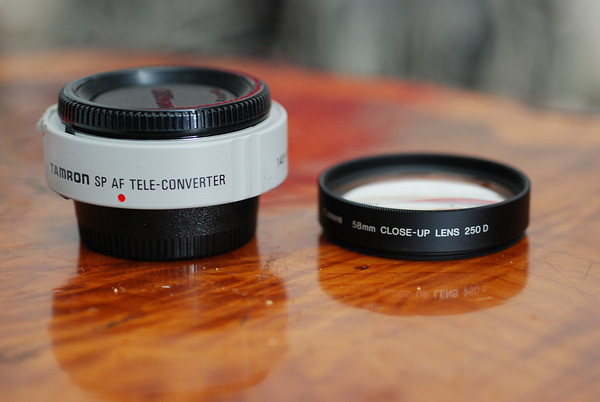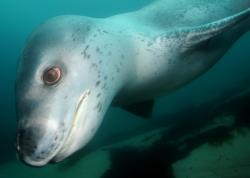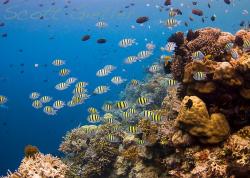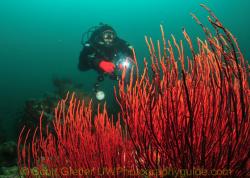Underwater Supermacro photography
Many underwater photographers get frustrated attempting underwater supermacro photography. However, for those who persevere and practice, the rewards are great. With the right equipment (diopter or teleconverter), the right conditions (no surge), lots of bottom time, and the right subject (think small!) - supermacro underwater photography can produce extraordinary photographs.
Supermacro with Point and Shoots
Macro photography in compact cameras is accomplished two ways - by purchasing a camera that allows very close focus (2cm or less), or by purchasing macro "wet lenses", which are diopters that allow for closer focusing. Two of these wet lenses are often stacked on top of each other for extreme magnification.
Wet macro lens
The Subsee +10, Bluewater +7, and Nauticam CMC-1 macro lens, are all popular macro lenses (wet diopter) for compact cameras. Two of these are stacked together, and can be added or removed underwater. These are strong, high quality diopters, and they can also be used with a dSLR. Reefnet makes the Subsee adapter for most dSLR ports and a couple compact camera ports. You can read more about wet lenses.
dSLR Supermacro Underwater Photography
Macro photography with a dSLR is usually accomplished with a macro lens, which can achieve 1:1 magnification. Canon 60mm, Canon 100mm, oly 50mm, nikon 60mm, and nikon 105mm lenses are examples of these lenses. Cropped sensor dSLR's allow their users to full-frame objects that are 24mm across or less. Full frame dSLR users must use additional teleconverters or diopters to achieve this effect.
If you are a Olympus user, your main choice will be a Oly 50mm F2.0 macro lens with a 1.4x or 2.0x teleconverter.
Super Macro photography - introduction
Using diopters or teleconverters to achieve greater than 1:1 magnification is called super-macro photography. At this range, DOF is very small, and auto-focus may be hard to achieve. Most photographers will focus in 1 of 3 ways: 1) switch to continuous focus mode, 2) focus at the maximum magnification, switch to manual focus mode, and then "rock" until the subject is in focus, or 3) purchase a focus ring and manually focus using the focus ring. Having the ability to switch between C, M, and S (continuous, manual, single-servo) focus modes via your UW housing is a very nice feature when performing super-macro photography.

Tamron 1.4 teleconverter & Canon 58mm 250D +4 dual-element diopter
Diopters, or Close-up lens
A diopter, also called a close-up lens, acts like a filter, and screws onto the front of the lens. A diopter allows for greater magnification by shortening the effective focal length of the lens, and reducing the working distance of the lens. The effective focal length of the lens is reduced. Where teleconverters maginify the image the same amount on all lenses, diopters will give different magnification on different focal lengths. So the magnification a diopter gives on a 150mm lens will be greater than that on a 60mm macro lens.
Advantage of using a diopter
No loss of light, which means bright viewfinder, no loss of auto-focus
Disadvantage
You lose the ability to get infinity focus, resulting in a reduced focal range. The stronger the diopter, the more the focal range is reduced.
Wet Diopters - Woody's, Macromate, Subsee, Dyron
"Woody's diopter", the "macromate", the Dyron Double Macro M77, and the "subsee" are wet diopters that can be placed over a port, that will allow for increased magnification by reducing the minimum working distance. The macromate and the Subsee are stronger diopters, but much more expensive. Woody's diopter can increase magnification up to 25%, where the macromate (+8) & subsee (+10) can increase magnification up to 100% & 125% respectively on a 105mm lens. These figures will be different on other focal lengths, as I discussed above.
Please note that when using a wet diopter, it's important that the camera lens is as close as possible to the port, to reduce the amount of air between the camera lens and the wet diopter. These diopters are best used with a 90mm focal length or longer, otherwise you will be focusing too close to your port. Still, some people do use a Woody's diopter with a 60mm lens.
A big advantage of a wet diopter is that is can be removed during the dive, so you don't have to shoot only supermacro on that dive.
SubSee: http://www.bluewaterphotostore.com/products/search/results/taxonomy%3A157
Dyron +7 Lens: https://www.bluewaterphotostore.com/dyron_77mm_macro_lens
You can read my review of the SubSee adapter and diopter.
Learn about shooting super macro with stacked diopters.

Blenny, uncropped, with SubSee wet diopter. Photo by Keri Wilk. The depth of field in this shot is very small, so it took several shots to get the eyes in focus. The blenny was in a tube, so to prevent the background from being illuminted, the strobes were at the side pointed slightly towards the camera housing. D300, 105mm lens with SubSee, dual Ike-125s without diffusers.

Nudibranch Rhinophores, Nikon D300, 105mm lens+subsee diopter. F25, 1/250th, ISO 200, Channel islands, USA
"Dry" diopters
A high-quality diopter such as the Nikon 5T/6T, which are no longer made, or a Canon 500D/250D is a small lens that is screwed onto the end of a macro lens. This will allow increased magnification by reducing the minimum working distance. There is very little image degradation with these high-quality diopters. These diopters are called "dual element" or achromatic diopters. B&W, hoya and tiffen also make cheaper diopters, but you may see some loss of IQ with these diopters.
The disadvantage of "dry" diopters is that the diopter must be used for the entire dive, and the lens will no longer focus at longer distances. Only small subjects will be able to be shot during the dive. A port extension may be needed to prevent the diopter from hitting the glass of the port.
Try to get a diopter called “two element” or “achromatic” like the Nikon or Canon versions, they are better quality than the one element diopters. Remember, when searching on-line, they are sometimes under “close-up lens”.
Diopter strength, and possible magnification over 1:1 on a 100mm lens
Canon 500d +2 20-30%
Nikon 4t, 6t +3 30-40% (discontinued and not easy to find)
Canon 250d +4 40-50%
Cheaper, single-element diopters can introduce chromatic aberrations, which can be corrected in photoshop or some RAW editors.

Garibaldi eggs, 105mm lens with Canon 250D diopter, F18

Conch eyes, Anilao, Phillipines, photo by jeff de guzman. f22, 1/160th, ISO 100, Canon 400D, +2 dry diopter, woody's wet diopter
Teleconverters
A teleconverter acts like a magnifier, and is placed in between a lens and the camera body. It magnified whatever lens is placed on it. More precisely, a teleconverter enlarges the center portion of the image until it fills the frame.
A 1.4x teleconverter magnifies all images by 40%, a 1.7x teleconverter by 70%, and a 2.0 teleconverter by 100%. The disadvantage is loss of light and loss of image quality. With a 1.4x teleconverter, you loose 1 stop of light. With a 2x, you lose 2 stops. To avoid image degradation, only use a teleconverter on a prime lens. There will be no noticeable loss of sharpness with a 1.4x teleconverter and a F2.8 lens. A larger port or port extension will be needed to accommodate the teleconverter. Not all teleconverters will allow you to autofocus, so do your research.
Example: Nikon 60mm lens + Kenko/Tamron 1.4x teleconverter

Colemani shrimp, shot with a 60mm lens + 1.4x teleconverter. F20, 1/320th

Nudibranch gills, nikon 105mm + 1.4x teleconverter. This is a good combo when you want to shoot very skittish subjects, and also do some supermacro. F14, 1/320th, ISO 250
I often use a tamron 1.4x tele with my Nikon 60mm lens, housed in a 105mm macro port. Maximum magnification is 40% greater than 1:1. The lens acts like an 85mm lens, which is perfect for smaller fish, and at maximum magnification has the same working distance as my 60mm. Autofocus works perfectly fine with this setup, although it auto-focus gets a little difficult at maximum magnification if you don't have a bright focus light.
Note: using a “dry” diopter or a teleconverter will make you need an extension ring if you don’t have enough room in your port.
Which brand teleconverter?
You can get either the Tamron SP AF (make sure it's the SP AF, not the standard) or the Kenko Teleplus 300 Pro. Both are exactly the same, made by the same manufacturer, simply rebranded and colored differently.
Teleconverter pros & cons
Pros - entire focal range of a lens is useable
Con - loss of light, therefore slightly dimmer viewfinder, auto-focus doesn't work as well. with a 1.4x tele, you lose 1 stop of light. 1.7x, 1 1/2 stops. 2x teleconverter, you loose 2 stops of light.
Cons - teleconverters magnify all defects of a lens (noise, artifacts, lack of sharpness, etc.), so they must be used on a high-quality lens that has better resolution than your sensor; you will lose some resolution and contrast with a 1.4x teleconverter. You'll also lose some auto-focus speed, especially on a 100-105mm lens, it can get quite noticeable in water that is not bright.
note - in general you should use teleconverters on prime lenses, not on zoom lenses.
On a prime lens, you shouldn't notice any loss of IQ with a 1.4x teleconverter. You might notice a small loss of IQ with a 2x teleconverter.

Goby on a coral, D2x, 105mm lens + 2x teleconverter at F29. Photo by Rand McMeins.
Extension tubes
I don't recommend using these, I think it is better to use a diopter or teleconverter. The extension tubes will make your port needs much longer, and you have to deal with loss of light. However, to use a teleconverter on the Canon EF-S 60mm lens, you need to use the Canon 12mm extension tube.
Supermacro Photography recommendations and tips:
Supermacro photography is when you take a photograph at greater than 1:1 magnification. One definition is if you are taking a photo that is less than 24mm across, you are shooting supermacro.
Best choices for supermacro with a dSLR:
- Use a cropped sensor dSLR
- Use one of the following combinations:
Olympus 50mm or Nikon/Canon 60mm macro lens
I recommend a teleconverter. I suggest starting off with a 1.4x teleconverter, although some people try the 2.0x. The Canon EF-S 60mm lens will not autofocus with a teleconverter. It will work if you place a 12mm extension tube in between the 60mm lens and the teleconverter, but use a good focus light to help with the auto-focus, you loose a little more light because of the extension tube making auto-focus even more difficult.
100 or 105mm macro lens (or longer focal length)
I recommend a wet or dry diopter (or combination of the two). A 100/105mm lens with a +2 dry diopter and a Woody's wet diopter is a combination that works well. You can also go for a stronger wet diopter (mentioned above) if your budget allows, which will give additional magnification.
Here's some basic information on comparing shooting a 60mm with a 105mm lens.
See the diopters section above for wet & dry diopter choices.
I do not recommend using a 50mm or 60mm lens with a diopter, unless it's only a +2. The working distance is very small, the subject will be very close to your lens port. This will make lighting difficult, it will scare the subject and make it difficult to get a correct composition.
Some people also have combined teleconverters and diopters for increased magnification. Make sure your port is long enough.
Supermacro with a micro-four thirds camera
There are 2 macro lenses available - the Panasonic 45mm macro, and the Olympus 60mm macro lens. I would use a wet +5 or +7 diopter with the Olympus 60mm macro lens, for great photos of really tiny subjects! The 60mm macro will give you a little more working distance than the 45mm macro.
SuperMacro Underwater Photography Advice
Before you go out and start buying all these diopters and teleconverters, make sure you have lots of practice taking photos at 1:1 magnification. Supermacro can be very difficult, and first you should take some photos at the maximum magnification of your lens, to see if that is magnification enough.
For your first time, you can try focuses the lens to its closest focusing distance, that turning off the autofocus on the lens. For the entire dive, you can rock back and forth to get in focus. This will ensure all of your shots are at the maximum magnification of your macro lens.
When shooting supermacro, you are often shooting at very small apertures, such as F22-F32. You may need to bring your strobes closer to your subject to get sufficient strobe power to light the subject at these small apertures.
Depth of Field
Some of us learn in landscape photography that the depth of field lies one third in front of the focus point, and 2/3 behind. That is only true in certain cases. In macro photography, the depth of field lies equally in front and behind the focus point. In supermacro, the depth of field will be very small, so choose your focal point carefully, and use at least F16, even for a flat object. Some people shoot at F36, F40, or F57. If you are worried about diffraction, see my diffraction test results.
Lighting and Focusing Tips
When doing any kind of photography close to 1:1, there is loss of light due to the lens elements being moved further away from the camera sensor. Because of this, the viewfinder will be slightly dimmer, so use a good focus light if possible.
Many TTL systems will underexpose when doing underwater supermacro photography, so make the appropriate adjustments, or switch to manual strobe power.
Lighting can be difficult, for even front lighting I suggest moving your strobes close in directly against your ports, pointing straight ahead. Here are some strobe position examples. To bring out detail in the subject, use side-lighting by pointing your strobes inward toward your port.

Tiny frogfish taken in Anilao, Philippines. Sidelighting helped to bring out the detail in the frogfish.
Composition Tips
You can find some supermacro composition tips here under underwater supermacro composition.
Here's a great article on "face-on" underwater macro composition.
Photo Workshop
Why not test , and improve your skills on one of our photo workshops
Further Reading:

RECOMMENDED ARTICLES
SUPPORT THE UNDERWATER PHOTOGRAPHY GUIDE:
The Best Service & Prices on u/w Photo Gear
 Visit Bluewater Photo & Video for all your underwater photography and video gear. Click, or call the team at (310) 633-5052 for expert advice!
Visit Bluewater Photo & Video for all your underwater photography and video gear. Click, or call the team at (310) 633-5052 for expert advice!
The Best Pricing, Service & Expert Advice to Book your Dive Trips
 Bluewater Travel is your full-service scuba travel agency. Let our expert advisers plan and book your next dive vacation. Run by divers, for divers.
Bluewater Travel is your full-service scuba travel agency. Let our expert advisers plan and book your next dive vacation. Run by divers, for divers.































